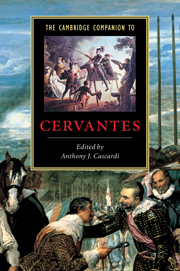Book contents
- Frontmatter
- 1 Introduction
- 2 The historical and social context
- 3 Cervantes and the Italian Renaissance
- 4 Don Quixote and the invention of the novel
- 5 The influence of Cervantes
- 6 Cervantes’ other fiction
- 7 Writings for the stage
- 8 Humor and violence in Cervantes
- 9 Psyche and gender in Cervantes
- 10 Cervantes and the New World
- Appendix: electronic editions and scholarly resources
- Index
- Series List
5 - The influence of Cervantes
Published online by Cambridge University Press: 28 May 2006
- Frontmatter
- 1 Introduction
- 2 The historical and social context
- 3 Cervantes and the Italian Renaissance
- 4 Don Quixote and the invention of the novel
- 5 The influence of Cervantes
- 6 Cervantes’ other fiction
- 7 Writings for the stage
- 8 Humor and violence in Cervantes
- 9 Psyche and gender in Cervantes
- 10 Cervantes and the New World
- Appendix: electronic editions and scholarly resources
- Index
- Series List
Summary
The influence we are concerned with is that of Don Quixote. Without question Cervantes would be remembered for his other works, his romances, plays, and especially the exemplary tales. But the legend of the man himself – his life of hardship and imprisonment, the loss of the use of his hand at the battle of Lepanto – would not be memorable if it were not for the appearance of El ingenioso hidalgo Don Quixote de la Mancha in 1605 and its continuation, in defiance of a spurious sequel, in 1615. Part i was translated into other major European languages almost immediately, Part II thereafter. The completed work became not a staple of Western civilization but a renewable source of its literature.
The immense influence of the work is also remarkable for being twofold: even as Cervantes’ method offered a flexible model for realism in the novel, his runaway hero, the self-created Don Quixote, became the model of rare heroism in the face of mundane reality. Both resources, the Cervantine method and the quixotic hero, have become closely associated with realism in the novel but need not be invoked in the same text. In truth, allegiances to the method and to the hero have generally been divided, as novelists and their critics have been engaged with the formal and philosophical problems of realism or with justice – not justice as a sustainable achievement, if there is such a thing, but as an ardent desire. Only very exceptional novels, original in their own right, draw upon both lessons from Cervantes.
- Type
- Chapter
- Information
- The Cambridge Companion to Cervantes , pp. 80 - 99Publisher: Cambridge University PressPrint publication year: 2002
- 5
- Cited by

